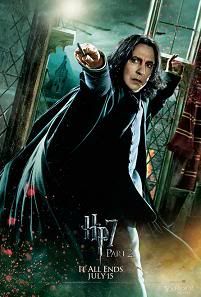Harry Potter—Character Analysis: Sorting Snape
By Bec C.

So are Slytherins truly all bad? Isn’t this rather a stereotype, created by none other by an 11 year old Ron Weasley when he so famously said “There's not a single witch or wizard who went bad who wasn't in Slytherin.” Or, alternatively by Hagrid in the movies, with the exact same quote. And thus from the worlds of a child the stereotyping began. Of course this stereotyping was aided by Harry’s own decision to choose Gryffindor, who are the natural rivals of Slytherin, and whose rivalry is designed to make first time readers despise the house and its students who are shown to be not above a little foul play every now and again. They are the ambitious house, after all, prepared to do whatever they can to make sure their plans come about. But does this mean they are evil?
We see the book from Harry’s perspective after all. Harry, the brave Gryffindor, rival of the ‘evil’ Draco of Slytherin. Why would we not see Slytherin as churning out evil wizards, when so many in Harry’s year proved to be that way. After all we have Draco, who brought death eaters into the school, and Crabbe and Goyle who we cannot deny grew up to be a bit on the bad side of tings. And of all the houses, it was the Slytherins who wanted to turn Harry in during the battle of Hogwarts, and who had to be led from the castle, and who didn’t fight to protect their school? Isn’t that how the story went?
Of course what is not mentioned is something J.K. Rowling herself mentioned in an interview with Pottercast. That of the Slytherins who were forced to leave Hogwarts that night, not on the side of the death eaters, but on the side of Hogwarts, choosing to risk their lives fighting for their school, even when some had friends and family fighting for the other side. And Slughorn, despite his apprehension, also chose to fight during that fight, to defend Hogwarts and its students. And while it may be said that Slughorn provided a young Tom Riddle with information of an evil nature, Slughorn himself was never seen as evil. He was merely a professor, doting on his favourite students, a kind professor, willing to assist those he saw as having potential. Even Draco, it can be argued, was not truly evil, despite becoming a death eater. Rather, Draco seems like a boy who made all the wrong choices, not because he wanted to, but because it was expected of him, because he did what he had to do for his family. In the movies you can visibly see the conflict in Draco’s face when once again he is forced to choose between his family, and what is right. While he may have made some evil choices, Draco is not evil, rather he is just a conflicted young male.
So what of the Gryffindors? If the Slytherins aren’t all bad, then by contrast does that mean the Gryffindors aren’t all good? They are the house that prides themselves on courage and bravery, which often leads to doing what is right, so surely no one from their side would be bad or evil? And yet we don’t have to look far into the Gryffindor history to find someone who could be classed as evil, or at the very least was guilty of evil deeds. Peter Pettigrew was sorted into Gryffindor by the sorting hat, and soon became one of the Marauders, a foursome who, despite being slight bullies at school, had three members grow up to join the fight for good. But Peter Pettigrew betrayed them all.
Some say that Pettigrew was not truly a Gryffindor, but the sorting hat claims it is never wrong. Perhaps Pettigrew was brave, but just chose not to act that way. After all, it was not on the side of good that he sold his best friends to the dark lord. It was not with bravery on the side of good that he framed another best friend for murder, having that friend sent to prison for what should have been the rest of his life. It was not bravery that caused him to spend 12 or so years as a rat, hiding from all who knew him. And it was not bravery that sent him once again back to the dark side, helping Voldemort in his attempt to kill the son of his best friends, the same best friends he sold out many years ago. If anyone highlights how Gryffindors can turn evil as much as any other house, then surely that someone is Peter Pettigrew, who despite having people who accepted and trusted him, betrayed these people as much as one man can.
So if Gryffindors can be evil, and Slytherins can be good, or conflicted in their choices, then does this still mean that Snape should have been in Gryffindor. Take a look at part two of this analysis where I examine the notion of bravery, and how this relates to Snape's true house.
To read Part Two, click here.